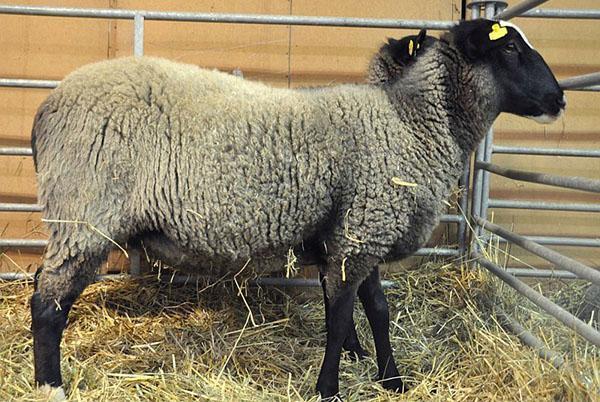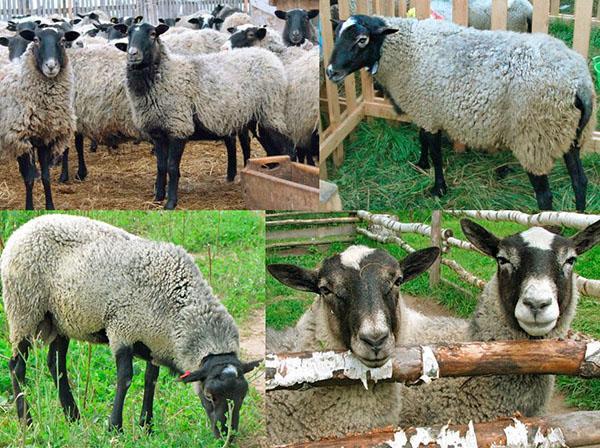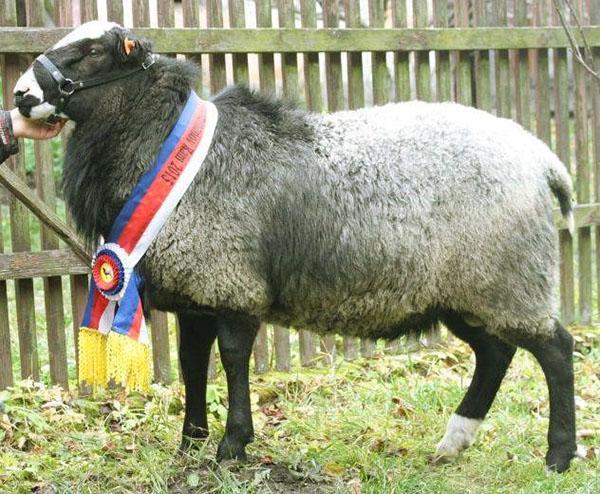The Romanov breed of sheep dresses half the world in fur coats
 Back in Peter's times in the Yaroslavl region, the Romano-Borisoglebsk district, the Romanov breed of sheep was bred. Short-tailed sheep have fur coat, tasty meat and quick brood. Unpretentious animals quickly settled in the northern area, Kazakhstan, Mongolian steppes.
Back in Peter's times in the Yaroslavl region, the Romano-Borisoglebsk district, the Romanov breed of sheep was bred. Short-tailed sheep have fur coat, tasty meat and quick brood. Unpretentious animals quickly settled in the northern area, Kazakhstan, Mongolian steppes.
The main features characterizing the Romanov sheep

The group of sheep breeds is called short-tailed, which fully describes the structure of this part of the body. The standard describes the breed as follows:
- height - average;
- chest - wide, deep;
- the back is straight;
- sacrum - sags;
- withers - wide;
- physique - strong;
- legs - straight, medium length.
The structure of the skeleton can be strong, tender and rough. Sheeps with strong bones are the most tenacious and give more offspring. They have a good, dense undercoat, the fluff 50-60 mm long does not roll. The color is dominated by a gray-blue color. Sheepskin is prized.
The coarse type of sheep of the Romanov breed has a massive skeleton, thick skin, and coarse wool with a lot of awn. The awn protruding above the fluff makes the color of the sheep dark or even black. These are the most unpretentious, tenacious sheep. Their wool is used for felting felt boots. The skin is unsuitable for fur coats, it is thick and heavy, coarse wool does not warm well.
The third type of skeleton is gentle. The Romanov breed of sheep with a thin skeleton has a narrow body. Everything is as if flattened from the sides - chest, head, legs standing close. And specific diseases - pulmonary. There is very little residue in the wool, so the sheep is white. But the flesh is thin, the skin is weak and the fertility is low.
Sheep manure is considered a very effective organic fertilizer. Its composition is concentrated, it should be used with caution, it is better in the form of liquid dressings or for stuffing a greenhouse.
The characteristic of the Romanov breed of sheep is the sum of the indicators.
Color standard - the fluff should be creamy white, the hair is black and always shorter than the fluff. The ratio of down to hair is 4/1 - 10/1. Newborn lambs should be black. After two to three weeks, they will gradually begin to acquire the breed color. Black head and tail, legs up to the hock, third of the torso. The border between the light and black parts is sharp. The lighting effects depend on the ratio of hair to fluff on each body part. If the dense undercoat does not allow the top down to fall off, the coarse hair creates a direction of growth, the long soft down can only twist on the top, creating beautiful curls with tints of gray.
Deviations from the standard are common, but for breeding sheep select standard individuals.
Breeding prospects of Romanov sheep
 Breeding Romanov sheep is not difficult.A lamb, called a bright sheep, is ready for fertilization from 4 months, but mating is done when the live weight of a bright is at least 40 kg, at about 7 months. Pregnancy lasts 145 days. During lactation, hunting and a new pregnancy may occur. Physiologically, offspring is possible twice a year. Breeding sheep of the Romanov breeds are prolific, they have 2 lambs the norm, sometimes more.
Breeding Romanov sheep is not difficult.A lamb, called a bright sheep, is ready for fertilization from 4 months, but mating is done when the live weight of a bright is at least 40 kg, at about 7 months. Pregnancy lasts 145 days. During lactation, hunting and a new pregnancy may occur. Physiologically, offspring is possible twice a year. Breeding sheep of the Romanov breeds are prolific, they have 2 lambs the norm, sometimes more.
 In favorable conditions and with proper care for the year, the herd can be increased by 3 times. The mother is ready to feed 3 lambs for 2 months. It is not always possible to completely preserve the offspring in a cramped shed during the period of mass lambing. If in the first minutes of a lamb's life the sheep did not lick it and did not let it near the udder, the newborn will die of hunger. Therefore, the task of a person is to find a woman in labor in a flock and slip a lamb to the udder. Nobody will feed someone else's baby.
In favorable conditions and with proper care for the year, the herd can be increased by 3 times. The mother is ready to feed 3 lambs for 2 months. It is not always possible to completely preserve the offspring in a cramped shed during the period of mass lambing. If in the first minutes of a lamb's life the sheep did not lick it and did not let it near the udder, the newborn will die of hunger. Therefore, the task of a person is to find a woman in labor in a flock and slip a lamb to the udder. Nobody will feed someone else's baby.
The more lambs a ram is born, the smaller the offspring, the lower the survival rate and the longer the fattening to marketable weight. One lamb weighs 3.7 kg, and each of the four weighs slightly more than 2. Therefore, in 100 days, the first one will weigh 25 kg, and a multiple lamb will gain only 16 kg.
After 3 weeks of feeding, lambs and queens are kept separately, a herd of adults is taken to graze, but at a certain time they are driven to feed. This regime creates better lactation. There is a possibility of manual feeding of lambs with selection of milk for food needs. Grown young growth is divided into kutsans and bright animals and grazed not only separately, but in different sectors. At this point, the females are already ready to mate.
Reproduction can take place unregulated and all year round if the herd has a breeder ram. In the farms, the offspring are planned so that it is possible to feed young animals with the best weight gain and wool quality. Therefore, mating is carried out at the same time in order to get a flock of the same age, suitable for the autumn slaughter. Keeping the Romanov sheep in sheeps in winter makes it right to mate in the fall, for the release of grown lambs on the pasture in the spring.
Feeding and caring for livestock
 The maintenance of Romanov sheep differs from the purpose of keeping the flock. Otara is completed from one age and one sex of sheep:
The maintenance of Romanov sheep differs from the purpose of keeping the flock. Otara is completed from one age and one sex of sheep:
- suckling young;
- kutsans;
- bright colors;
- maternal livestock;
- manufacturers.
With a koshar-basic method of keeping, each flock has its own sector, which has a pasture, a watering hole, a corral and a warm covered room. Several flocks of the same type can be placed nearby.
Sheep are ungulates. The hooves grind when the sheep walk on the steppe, hoof the ground. It is impossible to keep these animals without walking. For several hours a day, the herd must move, looking for food, even under the snow.
These animals need roughage. They consume more energy for physiological processes. The table shows the norms for the most responsible group of animals - the broodstock.
In winter, cattle are fed with roughage, it is useful for nursing mothers to get root crops, lambs are fed with bran and special compound feed from a week of age. From 3 weeks old babies are taught to silage and hay from legumes. It is necessary to provide an increase in live weight of 120-150 g / day. Breeders in the breeding period receive even a return in the diet for more active semen.
Commercial products
 Almost waste-free meat and wool sheep population is a very profitable production. From 5 months of age, production begins:
Almost waste-free meat and wool sheep population is a very profitable production. From 5 months of age, production begins:
- wool;
- meat;
- skins;
- milk
The wool of Romanov sheep is the most delicate, from the first harvest, is called poyarkovaya. This is a top quality product. In the future, the sheep are sheared 3 times a year, as the fluff grows. If the sheep are not trimmed on time, seasonal molting will begin, and the market value of the fleece will be lost. About 2 kg of wool are removed from the sheep, 3 kg of wool from the rams. The valuable material is used in light industry.After going through the POSH (primary processing of wool) factory, the product becomes clean, free from coarse fiber with a fleece.
At slaughter, the skins removed are degreased and sent for further processing. Perhaps your muton coat is made from the Romanov breed of sheep. Furriers believe that this is the best material for sewing high-quality soul warmers.
 Meat from sheep, lamb, is highly prized for its special flavor. It is known that sheep feed on grass, they are not fed with growth hormones - meat is a secondary product. Up to 20 kg of meat and offal are obtained from one young sheep during slaughter. Young lamb shashlik is appreciated all over the world.
Meat from sheep, lamb, is highly prized for its special flavor. It is known that sheep feed on grass, they are not fed with growth hormones - meat is a secondary product. Up to 20 kg of meat and offal are obtained from one young sheep during slaughter. Young lamb shashlik is appreciated all over the world.
Sheep milk is 2 times fatter and richer in minerals than cow's milk. The sheep is not a very productive animal. But if you keep a few lamb lambs, you can make cheese and other healthy dairy products.